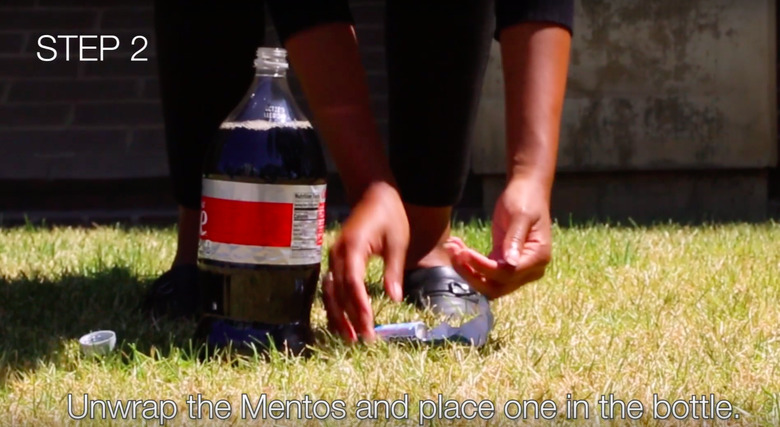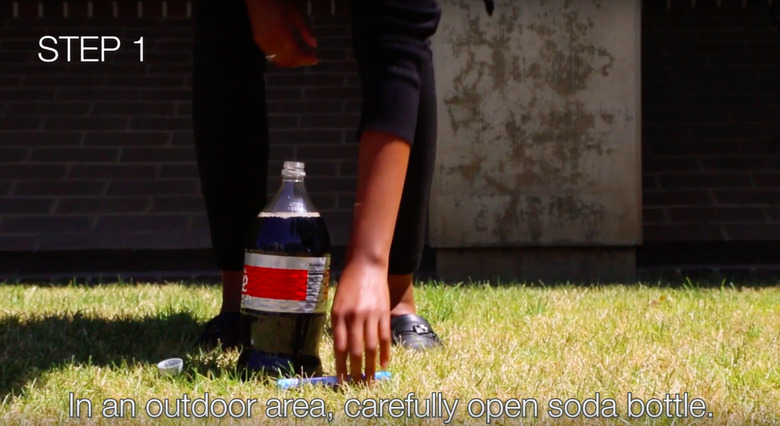Top Ten Most Popular Science Projects
Some science projects become old favorites at science fairs because they are simple to do, yet nice to look at, informative, and above all, fun. Here are some popular science fair projects that give a lot of bang for the buck.
Baking Soda and Vinegar Volcano
Baking Soda and Vinegar Volcano
This classic project uses baking soda, vinegar and red food coloring to simulate a volcanic eruption. You can make the body of the volcano out of clay or plaster. Try to make it as realistic as possible, with a convincing magma chamber, conduit and crater. When you are ready, mix a cup of vinegar and a spoonful or two of baking soda in order to create a foamy flow of lava.
Mentos and Soda Fountain
Mentos and Soda Fountain
This experiment is very easy to do, and is so fun it has been featured in a major TV ad and countless internet videos.
1. Carefully open soda bottle
It will reach a height of about six feet, so you may want to try this outdoors! (Also, you may want to use diet soda to avoid stickiness.)
2. Unwrap Mentos and place one in bottle
When you drop a roll of Mentos into a 2 liter bottle of soda, CO2 bubbles attach to the surface of the candy and grow as the candy dissolves. This creates a soda geyser almost instantly.
Invisible Ink
Invisible Ink
There are many different solutions that can make for an effective invisible ink. One of the most well-known is made from lemon juice. The juice of a lemon or two is likely to be enough: you only need enough to dip a small paintbrush that you will use to write your secret message.
The invisible ink can be made visible just by heating it carefully over a candle for a few seconds. For something with a bit more of a high-tech flair you can use Quinine Sulfate tablets to make an ink that will only become visible under UV light. Quinine sulfate is used for the treatment of malaria and is easy to find online.
Crystal Growing
Crystal Growing
There are many different techniques for having fun with crystals. One of the most colorful methods involves dropping metal salts like calcium chloride, lead nitrate or copper sulfate into a solution of sodium silicate, but you will need to borrow those from the school's chemistry lab.If you would rather use off-the shelf materials for your crystal growing experiments, you can create a warm saturated solution with a crystal solute like salt, sugar, alum or aniline. Dip a bit of string into it and wait for it to cool off. The particles in the solution will aggregate around the surface of the string and create tiny seed crystals.After a few days you will have some gorgeous crystal formations.
Vegetable Battery
Vegetable Battery
Vegetables do not have electricity per se, but they have electrolytes that can transport a current when sandwiched between two different metals. The classic version of this experiment involves a lemon, a galvanized nail and a copper coin connected to a small light bulb or a LED, but you can experiment with different vegetables and different metals and record the results. If you want to make your results more precise (and more "scientific-looking") you can use an inexpensive multimeter to measure the precise voltage produced.
Wind Energy
Wind Energy
Sustainable energy is all the rage these days, and you can build several simple experiments around the generation of wind energy. The rotor of a wind generator works on the same principles used by the humble pinwheel, so you can buy or make pinwheels of different sizes and different numbers of blades and look for the things that make them go slower or faster.If you use an electric fan or a hair dryer, you can also stress-test the different designs and materials to see if some handle high speeds better than others.
Water Electrolysis
Water Electrolysis
Hydrogen is another potential source of sustainable energy, and you can easily generate some by disintegrating water into its basic elements via an electrical current.Take a large battery (9 Volts or above), connect wires to its terminals and dip them into salty water. You should see bubbles forming around the tips of the wires as the water breaks down into oxygen and hydrogen.Try using different materials for the electrodes (like nails, or the graphite from a pencil), and different additives for the water (like vinegar, or distilled water), in order to achieve a more efficient process and generate more bubbles.
Plant Science
Plant Science
Place a few beans in a glass jar full of wet cotton. They will sprout within a few days, providing you with the material for some interesting botanic experiments: Can you make the sprouts grow faster if you place them in the sunlight? How about electric light? What if you keep one in the shadows, and what if you mash a vitamin tablet and add it to the water? You can use a ruler and keep a journal of the growth of the sprouts under different conditions.
Magnetic Fields
Magnetic Fields
You can create some beautiful patterns just by placing a magnet on a white sheet of paper and sprinkling some iron filings around it. The fillings will trace the invisible lines made by the magnetic fields, and you can use this to compare the power and the characteristics of different magnets. You can repeat this experiment using several magnets close to each other in order to see the interaction of their fields, but you will have to tape them to the table or they will simply stick to each other.
Tooth Decay
Tooth Decay
Another oldie but goodie: Measure the effect that immersion in different liquids has on teeth. Drop a tooth on a glass of water, another on a glass of soda and another on a glass of vinegar, plus any other interesting liquids that you can think of, leave them there for a few days, and keep a diary recording the effects of the liquid on the enamel. If you do not have enough spare teeth in storage, you can also use seashells, which have a similar composition. You will never forget to brush your teeth after this!
Cite This Article
MLA
Valdez, Alan. "Top Ten Most Popular Science Projects" sciencing.com, https://www.sciencing.com/top-ten-popular-science-projects-6570510/. 13 September 2019.
APA
Valdez, Alan. (2019, September 13). Top Ten Most Popular Science Projects. sciencing.com. Retrieved from https://www.sciencing.com/top-ten-popular-science-projects-6570510/
Chicago
Valdez, Alan. Top Ten Most Popular Science Projects last modified August 30, 2022. https://www.sciencing.com/top-ten-popular-science-projects-6570510/


